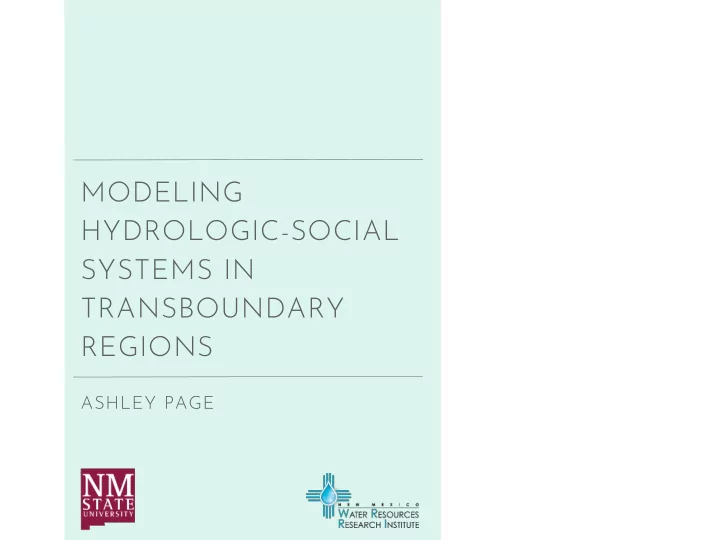

MODELING HYDROLOGIC-SOCIAL SYSTEMS IN TRANSBOUNDARY REGIONS ASHLEY PAGE
PRESENTATION STRUCTURE 2 • Introduction: System dynamics modeling • Background: Hydrologic-social system research • Summary: NM WRRI research team efforts • Applications: Modeling for transboundary regions
SYSTEM DYNAMICS MODELING 3 The purpose of a system dynamics study is to understand the causes of a dynamic problem, and search for the policies that alleviate/eliminate them. (BARLAS, 2002 )
SYSTEM DYNAMICS MODELING, continued 4 Discovery • Created by Jay Forester in the 1950s Strengths • Understanding nonlinear behavior • Complex systems (MIT Sloan School of Management, 2008)
HYDROLOGIC-SOCIAL RESEARCH 5 Background • Malin Falkenmark in 1979 • Resurgence in recent years • Potential for transboundary regions • (Blair and Buytaert, 2016) (Stockholm International Water Institute, 2018)
HYDROLOGIC-SOCIAL MODELING OF 6 TRANSBOUNDARY REGIONS A system dynamics approach allows for the analysis of: • separate, yet intrinsically connected decision-making analysis • connected hydrologic system • unintended consequences (Torres, 2017)
NM WRRI SYSTEM DYNAMICS RESEARCH 7 • Sam Fernald, Director • Transboundary research region: • Mesilla Basin • Research interests: • Surface water-groundwater interactions • Watershed management effects on runoff and water quality • Water and society • Transboundary water management Contact: afernald@nmsu.edu
NM WRRI SYSTEM DYNAMICS RESEARCH 8 • Saeed Langarudi, Post-Doctoral Research Scientist • Transboundary research region: • Mesilla Basin • Research interests: • Natural resources management • Political economy • Public policy • Development economics Contact: lang@nmsu.edu
NM WRRI SYSTEM DYNAMICS RESEARCH 9 • Babak Bahaddin, Graduate Researcher • Transboundary research region: • Mesilla Basin • Research interests: • Archetypes and generic structures in water resources management • Socio-economic feedback loops in water systems • Dynamic mechanisms for closed Contact: babak@nmsu.edu surface and groundwater systems
NM WRRI SYSTEM DYNAMICS RESEARCH 10 • Yining Bai, Graduate Research Assistant • Transboundary research region: • Mesilla Basin • Research interests: • Regional groundwater resilience • Agricultural water usage • Efficiency of natural resource storage Contact: ynb@nmsu.edu
NM WRRI SYSTEM DYNAMICS RESEARCH 11 • Connie Maxwell, Graduate Research Assistant • Transboundary research regions: Mesilla Valley and Hatch Valley • Research interests: • Watershed restoration (multi- functional benefits, including flood mitigation) • Stormwater harvesting (mitigation of Contact: alamosa@nmsu.edu flood energy and aquifer recharge) • Community collaboration (working to develop NM WRRI’s Water and Community Collaboration Lab)
NM WRRI SYSTEM DYNAMICS RESEARCH 12 • Ahmed Mashaly, Graduate Research Assistant • Transboundary research region: • Southern New Mexico • Research interests: • Water-Energy Nexus • Implications of water and energy interactions • Analysis of integrated water and Contact: amashaly@nmsu.edu energy management
NM WRRI SYSTEM DYNAMICS RESEARCH 13 • Langarudi, Saeed, Ashley Page, Connie Maxwell, Yining Bai, Babak Bahaddin, and Alexander Fernald. 2019. “System - Wide Policy Solutions for Water Issues.” Submitted to the 37 th International System Dynamics Conference. Albuquerque, NM: System Dynamics Society. • A. Page, S. P. Langarudi, S. Forster-Cox, and A. Fernald. A Dynamic HydroSocio-Technical Policy Analysis of Transboundary Desalination Development. Journal of Environmental Accounting and Management, 7(1):87 – 114, 2019. doi: https://doi.org/10.5890/JEAM.2019.3.007. • Langarudi, Saeed P., Connie M. Maxwell, Yining Bai, Austin Hanson, and Alexander Fernald. 2019. “Does Socioeconomic Feedback Matter for Water Models?” Ecological Economics 159 (May): 35 – 45. • Bai, Yining, Saeed P. Langarudi , and Alexander Fernald. 2017. “Long -Term Dynamics of Acequia Population in New Mexico.” In 35th International Conference of the System Dynamics Society . Cambridge, MA. • Langarudi, Saeed P., and Carlos G. Silva. 2017. “Crop Price Volatility and Its Influence on Crop Patterns.” In Proceedings of the 2017 International Conference of The Computational Social Science Society of the Americas , 4:1 – 4:10. CSS 2017. New York, NY.
MESILLA BASIN HYDRO-SOCIAL 14 TRANSBOUNDARY RESEARCH Research: Evaluating Policy and Management Instabilities in the Transboundary Mesilla Basin Hydro-Social System to Rectify Public Health Concerns Ashley Page, Sam Fernald, Saeed Langarudi, Sue Forster-Cox, Humaira Rahman (El Paso Times, 2017)
PREVIOUS RESEARCH 15 • A Dynamic Hydro-Socio- Technical Policy Analysis of Transboundary Desalination Development Focus groups • Key findings • Cost • Reform • Quality • Need for Created by Robert Sabie Jr., NM WRRI further research
RESEARCH COMPONENTS 16 System Dynamics model • Hydrologic-social analysis to investigate the systematic instabilities that create a gap between the expressed health needs of the community and their rectification • Focus on the feedbacks between the hydrologic and social system • Analysis of unintended consequences
RESEARCH COMPONENTS 17 Hydrologic components Public health components Policy decision-making components
RESEARCH COMPONENTS, 18 continued Community • Meeting to discuss results from previous focus group • Receive updated feedback regarding their water-related and action concerns Public Health • Investigate the impact of arsenic contamination on the health of the community
CONTACT 19 Ashley Page apage@nmsu.edu
Recommend
More recommend